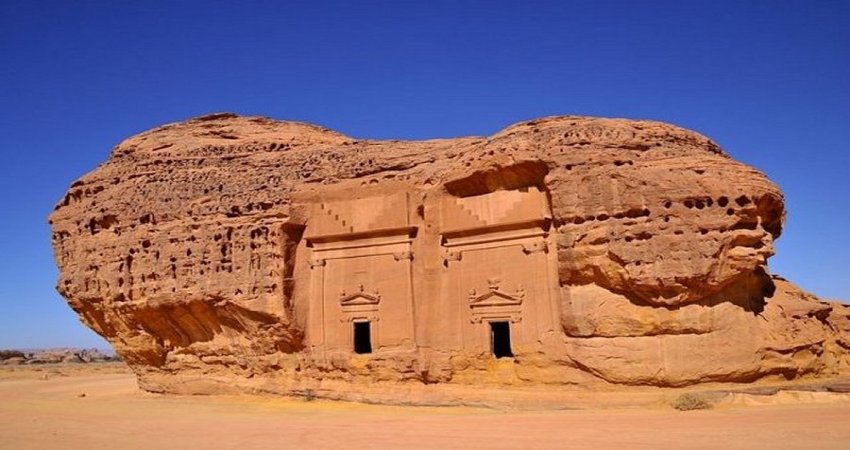The Enigma Of The ‘Ancient Ones’, The Anasazi Cliff-Dwellers Of The Southwestern United States
Thalia Lightbringer – MessageToEagle.com – No one really knows for certain what happened to the Anasazi. They attained a high level of culture for their time, then abandoned it all.
Did they exhaust their resources then lose faith in their way of life? Could they have had competition for the dwindling food and water sources from other tribes migrating to their area?
From Nomadic Beginnings To Complex Culture

The Anasazi began as nomadic hunter-gatherers, perhaps as early as 1500 BC. They occupied the valleys and plains in the “Four Corners” region of North America (where Utah, Colorado, Arizona, and New Mexico meet at the corners). They eventually adapted into a basket maker culture, clustering together in settlements with pit houses around 300-700 AD. Then for some reason they felt the need to change their ways drastically.
After this time, the Anasazi built great cities and ceremonial centers with kivas, special sacred buildings which were usually built underground with a hatchway at the top, which were used for religious rituals. The kivas are also associated with the Pueblo and Hopi tribes, connected with their belief in the Kachina spirits. The hatchway was symbolic of the gateway between our world and the “fourth world”, realm of the spirits.
The Anasazi may have adopted some of the ritual beliefs from other people coming to the area, since the Kachinas are thought to bring rain and fertility. These things became very important to them at the end of their culture.

The Anasazi studied the stars and developed complex calendars, using astronomical observations to pinpoint the proper times for sowing and harvesting their crops. Chaco Canyon in New Mexico seems to have been a center for astronomical studies and sacred ceremonies.
They did not have a written language, but left behind beautiful petroglyphs, symbolic art carved into the rocks. In their final period of development, the Anasazi moved to barely accessible canyons, building cliff houses surrounded by high walls in places with natural springs, such as at Mesa Verde, Colorado. This period of cultural development lasted until around 1300 AD. Then they seem to have decided to suddenly abandon all their achievements, some even leaving their possessions behind.
Need For Defense?

The Anasazi are often called the “Ancient Ones”, but the term comes from a Navajo word meaning “ancestors of our enemies”. Archaeologists refer to them as the “Mogollon” culture. We do not know what they called themselves, but the Hopi claim that the Ancient Ones are their ancestors. This might give us a clue as to why the Anasazi abruptly left their settlements less than 50 years after accomplishing the amazingly difficult feat of building dwellings sheltered high in canyon cliffs.
The Hopi are an extremely peaceful people, rarely engaging in warfare. They have been known to leave a settlement rather than fight with another tribe over it. The Navajo are believed to have come to the area from the north (based on similarities with the language of the Athabascan tribe in Canada) at around 1400 AD. Perhaps some of them arrived earlier than this and the Anasazi decided to leave, avoiding potential conflict. The building of cliff dwellings seems to point to a need for defense. Not only are they difficult to reach, but also quite hard to see unless you know what you are looking for.
Drought And Famine Leading To Loss Of Faith?

Another idea is that they had exhausted the resources of the area and after years of drought were losing faith in their traditions. There is a tale of a Hopi leader who asked a neighboring tribe to slaughter his people in the night, because they had strayed too far from their values.
It seems the Anasazi would also sacrifice themselves for their traditions. There have been remains found which indicate such sacrifice in the kivas of some Anasazi ruins, but seemed to be little or no evidence of violent conflict. However, more recent findings show that this was not always true and it is possible that the settlements fought amongst themselves, perhaps because of dwindling resources.
Since they used wooden beams in the construction of their dwellings, we know when they lived and that there were many years of drought. Accurate dates and information about the climate of the time has been obtained from these wooden supports using dendrochronology, a method of dating using tree rings.
Tree rings show that they had successfully survived periods of drought before, but maybe the final drought was compounded by other factors. Archaeologists have also found indications that hunger got so bad at the end that they resorted to cannibalism in some instances, though it is also possible that marauding enemies were responsible for this. Native legends speak of such raiders coming to the area.
It is now believed the Anasazi migrated to the Hopi mesas and Rio Grande valley, and are now known as the Hopi, Zuni and Pueblo tribes. Traditional tales of these people support some scientific findings that the exodus may have occurred gradually, in small groups, over a hundred-year period. Perhaps they just decided to go back to a simpler life, remembering their nomadic past when their traditions failed to save them from drought and hunger.
By Thalia Lightbringer – MessageToEagle.com Writer
Copyright © MessageToEagle.com All rights reserved. This material may not be published, broadcast, rewritten or redistributed in whole or part without the express written permission of MessageToEagle.com
Expand for references
World Documentary, Legend of the Anasazi…:
https://www.youtube.com/watch?v=TmPSHVgugy8
Suppressed History, Ancient Cliff Dwellings…:
https://www.youtube.com/watch?v=8pjrNGm_t-8
History Channel, Digging for the Truth, Josh Bernstein:
Related Posts
-
 Have Super Aliens Already Left Our Visible Universe? A Closer Look At The Transcension Hypothesis
No Comments | Aug 3, 2013
Have Super Aliens Already Left Our Visible Universe? A Closer Look At The Transcension Hypothesis
No Comments | Aug 3, 2013 -
 Evidence Of Ancient Lakes In The Sahara Desert Discovered
No Comments | Nov 5, 2022
Evidence Of Ancient Lakes In The Sahara Desert Discovered
No Comments | Nov 5, 2022 -
 Scientists Attempt To Unlock The Mysteries Of Ancient Ayurvedic Wisdom
No Comments | Nov 17, 2015
Scientists Attempt To Unlock The Mysteries Of Ancient Ayurvedic Wisdom
No Comments | Nov 17, 2015 -
 Mada’in Saleh: Spectacular Rock-Cut Tombs And Monuments Reflect Great Skills Of Nabataean Builders
No Comments | Aug 19, 2020
Mada’in Saleh: Spectacular Rock-Cut Tombs And Monuments Reflect Great Skills Of Nabataean Builders
No Comments | Aug 19, 2020 -
 Ring Of Fire With Powerful And Deadly Forces Lurking Deep Beneath Earth’s Surface
No Comments | May 7, 2017
Ring Of Fire With Powerful And Deadly Forces Lurking Deep Beneath Earth’s Surface
No Comments | May 7, 2017 -
 Mystery Of Ancient Symbols On A 2,700-Year-Old Temple In Khorsabad, Iraq – Solved
No Comments | May 10, 2024
Mystery Of Ancient Symbols On A 2,700-Year-Old Temple In Khorsabad, Iraq – Solved
No Comments | May 10, 2024 -
 Forest In Ancient Beliefs: Powerful Realm Of Good And Evil, Ghosts, Gods And Monsters
No Comments | May 19, 2016
Forest In Ancient Beliefs: Powerful Realm Of Good And Evil, Ghosts, Gods And Monsters
No Comments | May 19, 2016 -
 Source Of Ancient Roman Silver Was The Iberian Peninsula
No Comments | Dec 18, 2021
Source Of Ancient Roman Silver Was The Iberian Peninsula
No Comments | Dec 18, 2021 -
 2,500-Year-Old Large Untouched Scythian Burial Ground Unearthed In Khakassia, Siberia
No Comments | Oct 6, 2020
2,500-Year-Old Large Untouched Scythian Burial Ground Unearthed In Khakassia, Siberia
No Comments | Oct 6, 2020 -
 Secrets Of The Lost Ancient Sahara Civilization
No Comments | Sep 28, 2016
Secrets Of The Lost Ancient Sahara Civilization
No Comments | Sep 28, 2016
